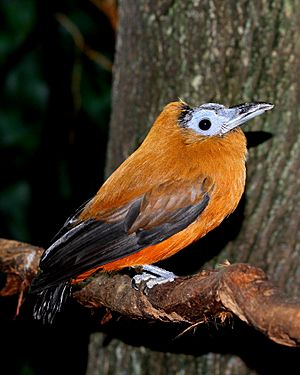Capuchinbird facts for kids
Quick facts for kids Capuchinbird |
|
|---|---|
 |
|
| Conservation status | |
| Scientific classification | |
| Genus: |
Perissocephalus
|
| Species: |
tricolor
|
 |
|
The capuchinbird or calfbird (Perissocephalus tricolor) is a very unique and large bird. It belongs to a special bird family called Cotingidae. This bird is the only one of its kind in the Perissocephalus group. You can find it in the wet forests of north-eastern South America. It lives mostly north of the Amazon River and east of the Rio Negro. This includes countries like Colombia, Venezuela, Brazil, and The Guianas.
Contents
What Does the Capuchinbird Look Like?
The capuchinbird is a big, strong bird with a thick beak. It weighs about as much as a small pineapple, between 340 and 420 grams. It's usually around 40 centimeters long. This makes it one of the largest birds in its group, called suboscine passerines.
Its feathers are a rich brown color. They get more orange on its belly and under its tail. Its wing feathers and short tail are black. The most interesting part of the capuchinbird is its head. It's bare, meaning it has no feathers, and looks a bit like a vulture's head. The skin on its head is a dull blue color. Young capuchinbirds look like adults, but they might have some soft, downy feathers on their heads.
How Do Capuchinbirds Live?
Capuchinbirds gather in special places called leks. These are like meeting spots where male birds show off to attract females. They make very strange sounds that people call "songs." It's hard to describe the sound exactly. Some people say it sounds like a faraway chainsaw. Others say it sounds like a young cow mooing, which is why it's also called a "calfbird."
Their nests are small and not very fancy. They are usually built close to these lek meeting spots. Capuchinbirds mostly eat fruits and insects.
Is the Capuchinbird in Danger?
The capuchinbird lives across a very large area. Even though you don't see them everywhere, there are many of them in total. Their numbers might be going down a little because of deforestation, which is when forests are cut down.
However, their population is not shrinking fast enough to be considered in danger. Because of this, the International Union for Conservation of Nature says the capuchinbird is a "least concern" species. This means they are not currently threatened with extinction.
See also
 In Spanish: Pájaro capuchino para niños
In Spanish: Pájaro capuchino para niños


